Special Report
This Is the City in Every State Where COVID-19 Is Growing the Fastest
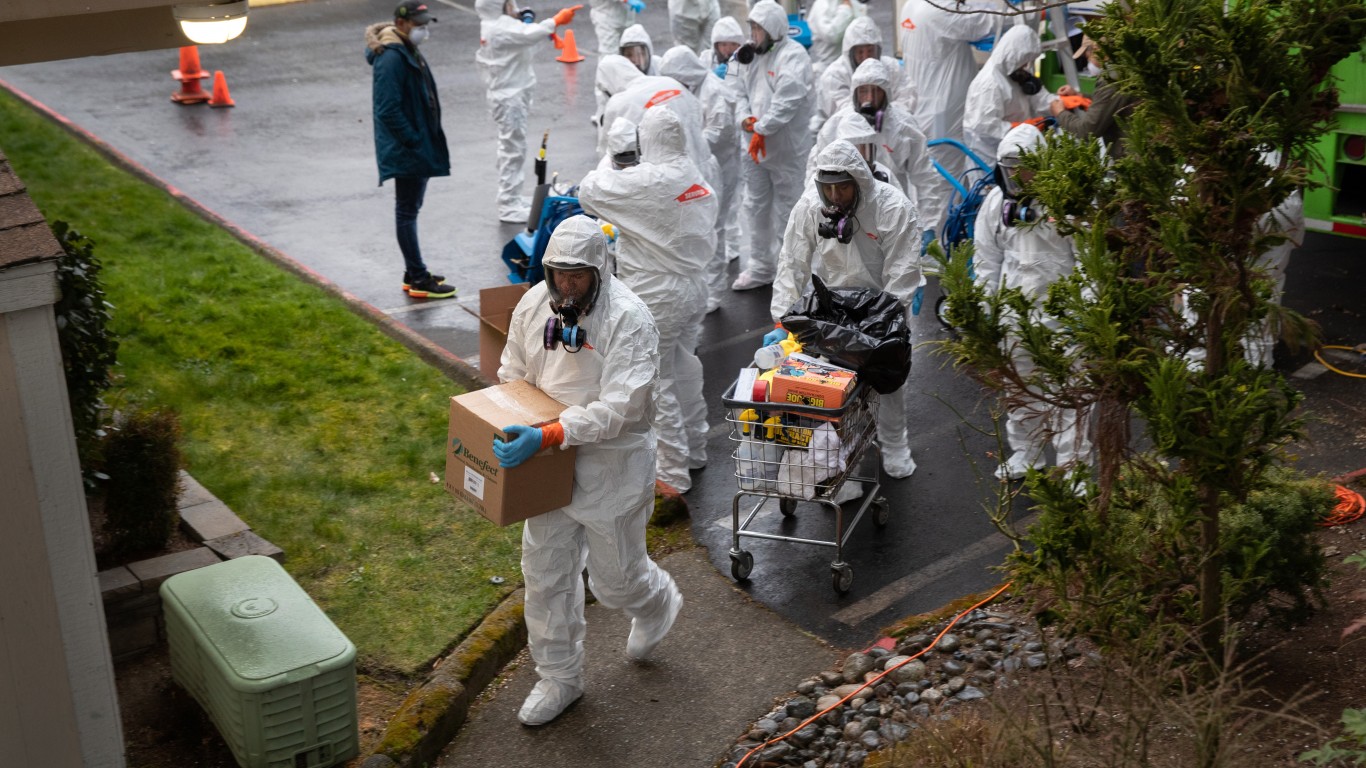
Published:
Last Updated:

The U.S. has reported more than 54.9 million confirmed COVID-19 cases as of January 4. There have been more than 819,000 reported deaths from COVID-19-related causes — the highest death toll of any country.
The extent of the spread of the novel coronavirus continues to vary considerably from state to state, and from city to city. Even as the number of daily new cases is flattening or even declining in some parts of the country, it is surging at a growing rate in others.
Nationwide, the number of new cases is growing at an increasing rate. There were an average of 89.2 daily new coronavirus cases per 100,000 Americans in the week ending January 4, an increase from the week prior, when there were an average of 47.8 daily new coronavirus cases per 100,000 people.
Metropolitan areas with a high degree of mobility and a large population may be particularly vulnerable to outbreaks. While science and medical professionals are still studying how exactly the virus spreads, experts agree that outbreaks are more likely to occur in group settings where large numbers of people routinely have close contact with one another. Cities with high concentrations of dense spaces such as colleges, correctional facilities, and nursing homes are particularly at risk.
The city with the highest seven-day average of new daily COVID-19 cases per capita is in New York. In the New York-Newark-Jersey City, NY-NJ-PA, metro area, there were an average of 255.8 daily new coronavirus cases per 100,000 residents in the week ending January 4, the most of any U.S. metro area. Other cities where COVID-19 is growing the fastest include Miami-Fort Lauderdale-Pompano Beach, FL; Cleveland-Elyria, OH; and Gettysburg, PA.
To determine the metropolitan area in each state where COVID-19 is growing the fastest, 24/7 Wall St. compiled and reviewed data from state and local health departments. We ranked metropolitan areas according to the average number of new daily COVID-19 cases per 100,000 residents in the seven days ending January 4. Data was aggregated from the county level to the metropolitan area level using boundary definitions from the U.S. Census Bureau. Population data used to adjust case and death totals came from the U.S. Census Bureau’s 2019 American Community Survey and are five-year estimates. Unemployment data is from the Bureau of Labor Statistics and is seasonally adjusted.

Alabama: Birmingham-Hoover
Avg. new daily cases in Birmingham in week ending January 4: 82.2 per 100,000
Avg. new daily cases in Birmingham in week ending December 28: 23.8 per 100,000
COVID-19 cases in Birmingham as of January 4: 212,662 (19,594.2 per 100,000)
Peak pandemic unemployment in Birmingham: 12.5% (April 2020)
Birmingham population: 1,085,330 (241.8 people per sq. mi.)
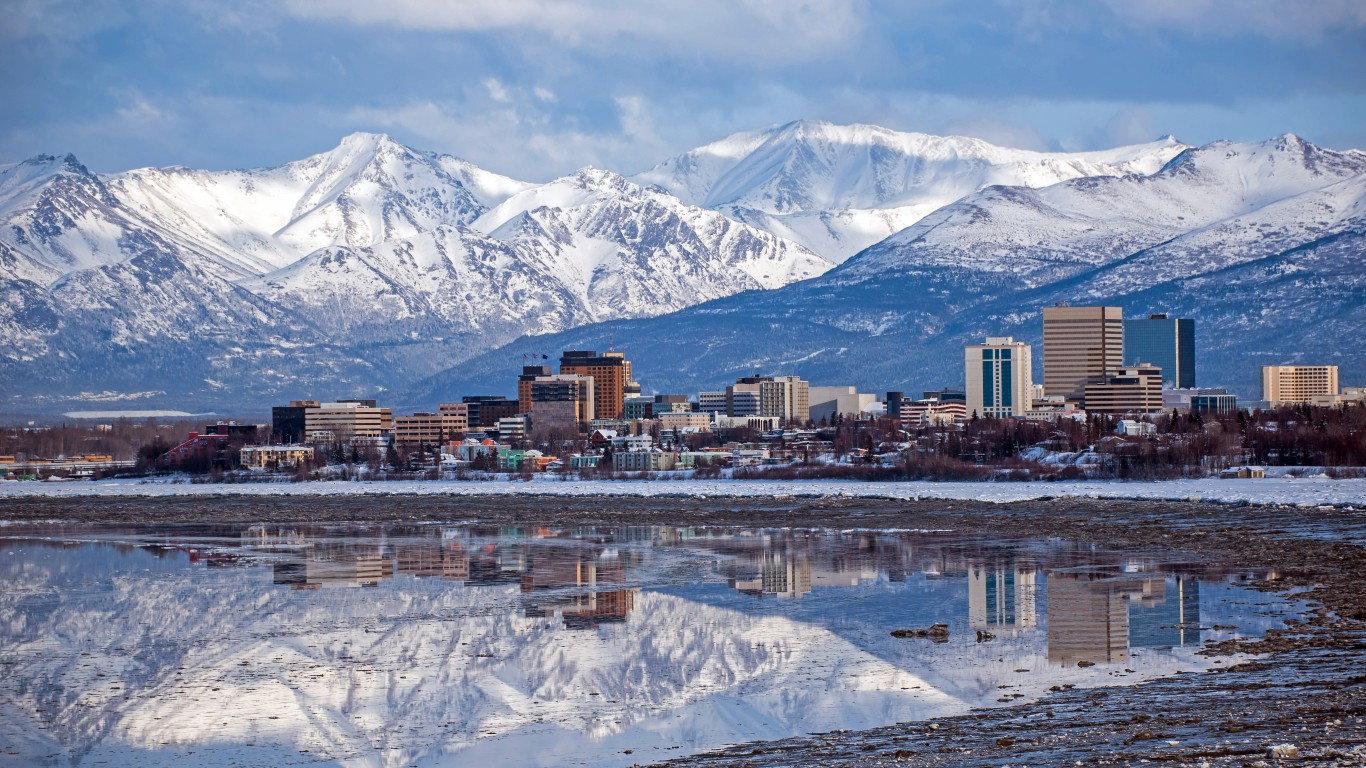
Alaska: Anchorage
Avg. new daily cases in Anchorage in week ending January 4: 25.6 per 100,000
Avg. new daily cases in Anchorage in week ending December 28: 18.1 per 100,000
COVID-19 cases in Anchorage as of January 4: 88,969 (22,303.6 per 100,000)
Peak pandemic unemployment in Anchorage: 14.8% (April 2020)
Anchorage population: 398,900 (15.2 people per sq. mi.)
These are all the counties in Alaska where COVID-19 is slowing (and where it’s still getting worse).

Arizona: Flagstaff
Avg. new daily cases in Flagstaff in week ending January 4: 75.0 per 100,000
Avg. new daily cases in Flagstaff in week ending December 28: 40.6 per 100,000
COVID-19 cases in Flagstaff as of January 4: 28,256 (20,000.8 per 100,000)
Peak pandemic unemployment in Flagstaff: 17.9% (April 2020)
Flagstaff population: 141,274 (7.6 people per sq. mi.)

Arkansas: Jonesboro
Avg. new daily cases in Jonesboro in week ending January 4: 157.6 per 100,000
Avg. new daily cases in Jonesboro in week ending December 28: 56.9 per 100,000
COVID-19 cases in Jonesboro as of January 4: 31,689 (24,145.7 per 100,000)
Peak pandemic unemployment in Jonesboro: 9.3% (April 2020)
Jonesboro population: 131,241 (89.5 people per sq. mi.)

California: Los Angeles-Long Beach-Anaheim
Avg. new daily cases in Los Angeles in week ending January 4: 88.7 per 100,000
Avg. new daily cases in Los Angeles in week ending December 28: 29.9 per 100,000
COVID-19 cases in Los Angeles as of January 4: 2,099,861 (15,848.5 per 100,000)
Peak pandemic unemployment in Los Angeles: 19.3% (May 2020)
Los Angeles population: 13,249,614 (2,732.8 people per sq. mi.)

Colorado: Denver-Aurora-Lakewood
Avg. new daily cases in Denver in week ending January 4: 91.5 per 100,000
Avg. new daily cases in Denver in week ending December 28: 37.1 per 100,000
COVID-19 cases in Denver as of January 4: 463,027 (16,010.3 per 100,000)
Peak pandemic unemployment in Denver: 12.3% (April 2020)
Denver population: 2,892,066 (346.5 people per sq. mi.)

Connecticut: Bridgeport-Stamford-Norwalk
Avg. new daily cases in Bridgeport in week ending January 4: 145.0 per 100,000
Avg. new daily cases in Bridgeport in week ending December 28: 67.2 per 100,000
COVID-19 cases in Bridgeport as of January 4: 140,261 (14,859.3 per 100,000)
Peak pandemic unemployment in Bridgeport: 10.6% (July 2020)
Bridgeport population: 943,926 (1,510.5 people per sq. mi.)

Delaware: Dover
Avg. new daily cases in Dover in week ending January 4: 132.1 per 100,000
Avg. new daily cases in Dover in week ending December 28: 97.2 per 100,000
COVID-19 cases in Dover as of January 4: 35,219 (19,931.6 per 100,000)
Peak pandemic unemployment in Dover: 17.3% (May 2020)
Dover population: 176,699 (301.4 people per sq. mi.)
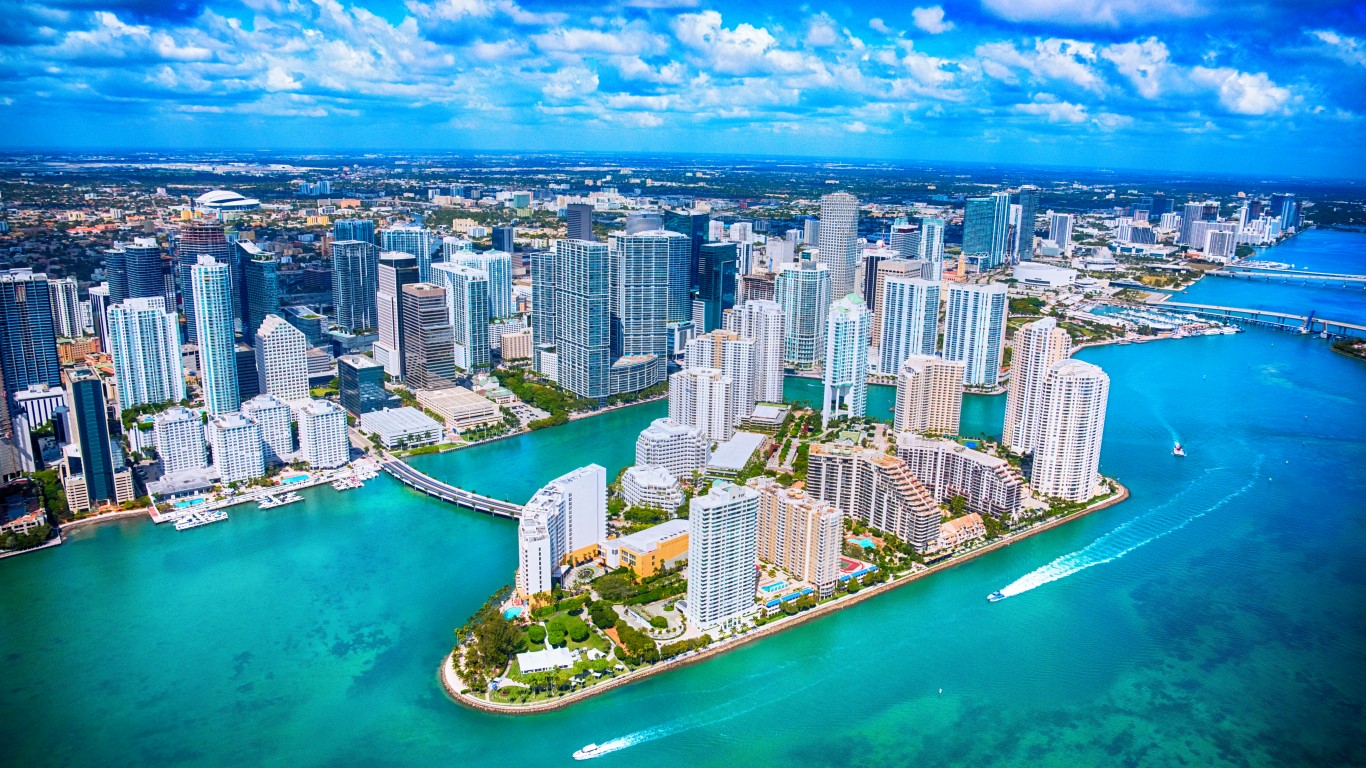
Florida: Miami-Fort Lauderdale-Pompano Beach
Avg. new daily cases in Miami in week ending January 4: 234.6 per 100,000
Avg. new daily cases in Miami in week ending December 28: 60.6 per 100,000
COVID-19 cases in Miami as of January 4: 1,568,562 (25,753.6 per 100,000)
Peak pandemic unemployment in Miami: 13.8% (April 2020)
Miami population: 6,090,660 (1,199.6 people per sq. mi.)

Georgia: Atlanta-Sandy Springs-Alpharetta
Avg. new daily cases in Atlanta in week ending January 4: 133.7 per 100,000
Avg. new daily cases in Atlanta in week ending December 28: 44.9 per 100,000
COVID-19 cases in Atlanta as of January 4: 986,264 (16,823.5 per 100,000)
Peak pandemic unemployment in Atlanta: 12.8% (April 2020)
Atlanta population: 5,862,424 (674.9 people per sq. mi.)

Hawaii: Urban Honolulu
Avg. new daily cases in Urban Honolulu in week ending January 4: 132.6 per 100,000
Avg. new daily cases in Urban Honolulu in week ending December 28: 66.7 per 100,000
COVID-19 cases in Urban Honolulu as of January 4: 84,664 (8,596.9 per 100,000)
Peak pandemic unemployment in Urban Honolulu: 20.7% (April 2020)
Urban Honolulu population: 984,821 (1,639.3 people per sq. mi.)
These are all the counties in Hawaii where COVID-19 is slowing (and where it’s still getting worse).

Idaho: Boise City
Avg. new daily cases in Boise City in week ending January 4: 29.3 per 100,000
Avg. new daily cases in Boise City in week ending December 28: 17.8 per 100,000
COVID-19 cases in Boise City as of January 4: 139,871 (19,679.5 per 100,000)
Peak pandemic unemployment in Boise City: 12.6% (April 2020)
Boise City population: 710,743 (60.4 people per sq. mi.)
These are all the counties in Idaho where COVID-19 is slowing (and where it’s still getting worse).
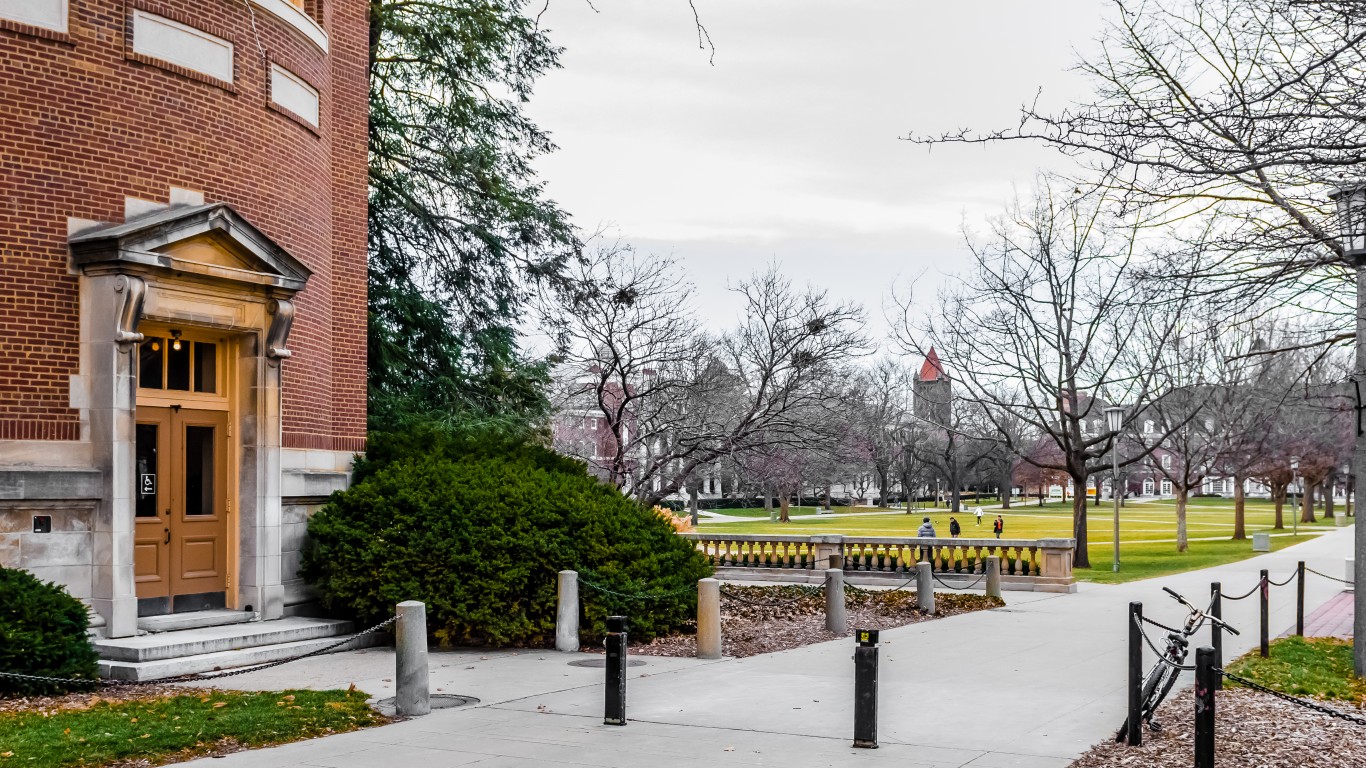
Illinois: Champaign-Urbana
Avg. new daily cases in Champaign in week ending January 4: 156.5 per 100,000
Avg. new daily cases in Champaign in week ending December 28: 92.3 per 100,000
COVID-19 cases in Champaign as of January 4: 40,485 (17,888.2 per 100,000)
Peak pandemic unemployment in Champaign: 12.2% (April 2020)
Champaign population: 226,323 (157.7 people per sq. mi.)

Indiana: Indianapolis-Carmel-Anderson
Avg. new daily cases in Indianapolis in week ending January 4: 80.5 per 100,000
Avg. new daily cases in Indianapolis in week ending December 28: 54.0 per 100,000
COVID-19 cases in Indianapolis as of January 4: 361,170 (17,796.3 per 100,000)
Peak pandemic unemployment in Indianapolis: 13.8% (April 2020)
Indianapolis population: 2,029,472 (471.3 people per sq. mi.)
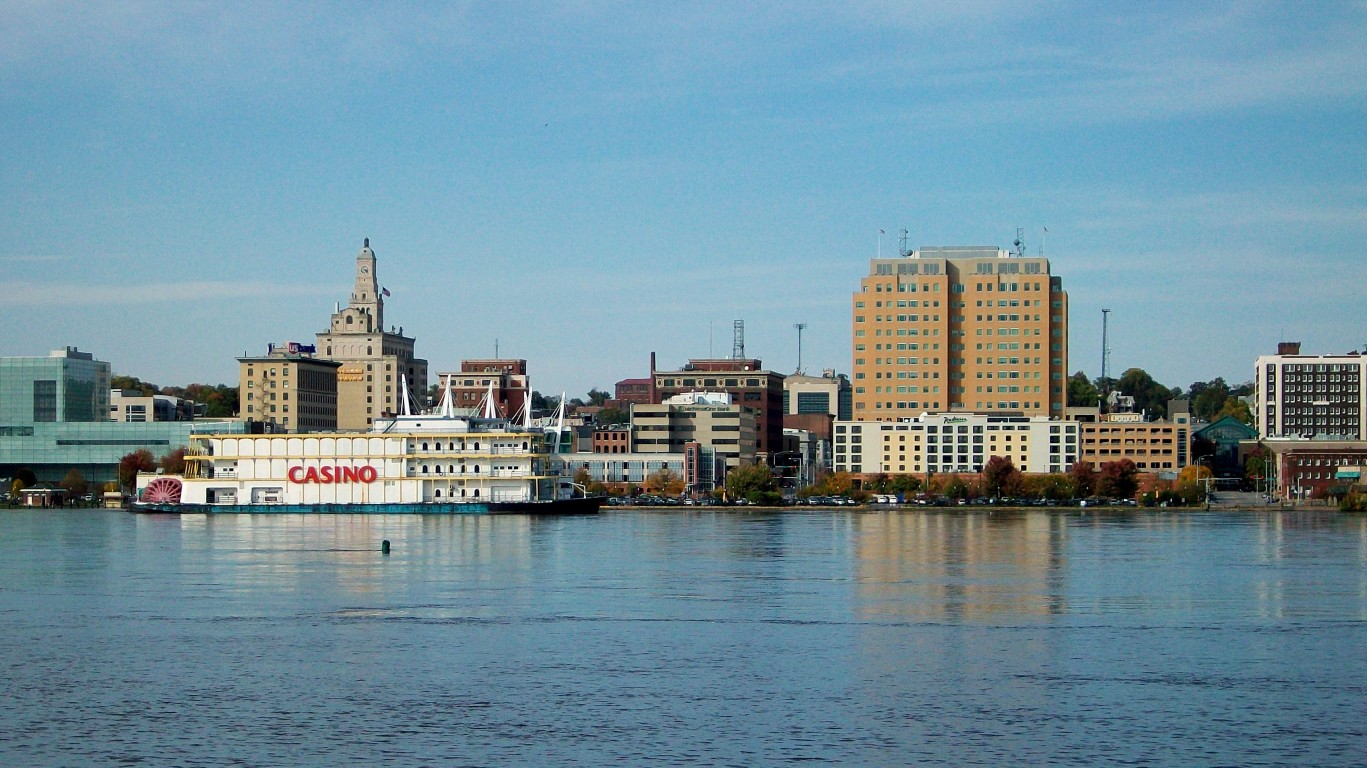
Iowa: Davenport-Moline-Rock Island, IA-IL
Avg. new daily cases in Davenport in week ending January 4: 78.5 per 100,000
Avg. new daily cases in Davenport in week ending December 28: 55.3 per 100,000
COVID-19 cases in Davenport as of January 4: 66,078 (17,335.3 per 100,000)
Peak pandemic unemployment in Davenport: 16.0% (April 2020)
Davenport population: 381,175 (167.9 people per sq. mi.)
These are all the counties in Iowa where COVID-19 is slowing (and where it’s still getting worse).
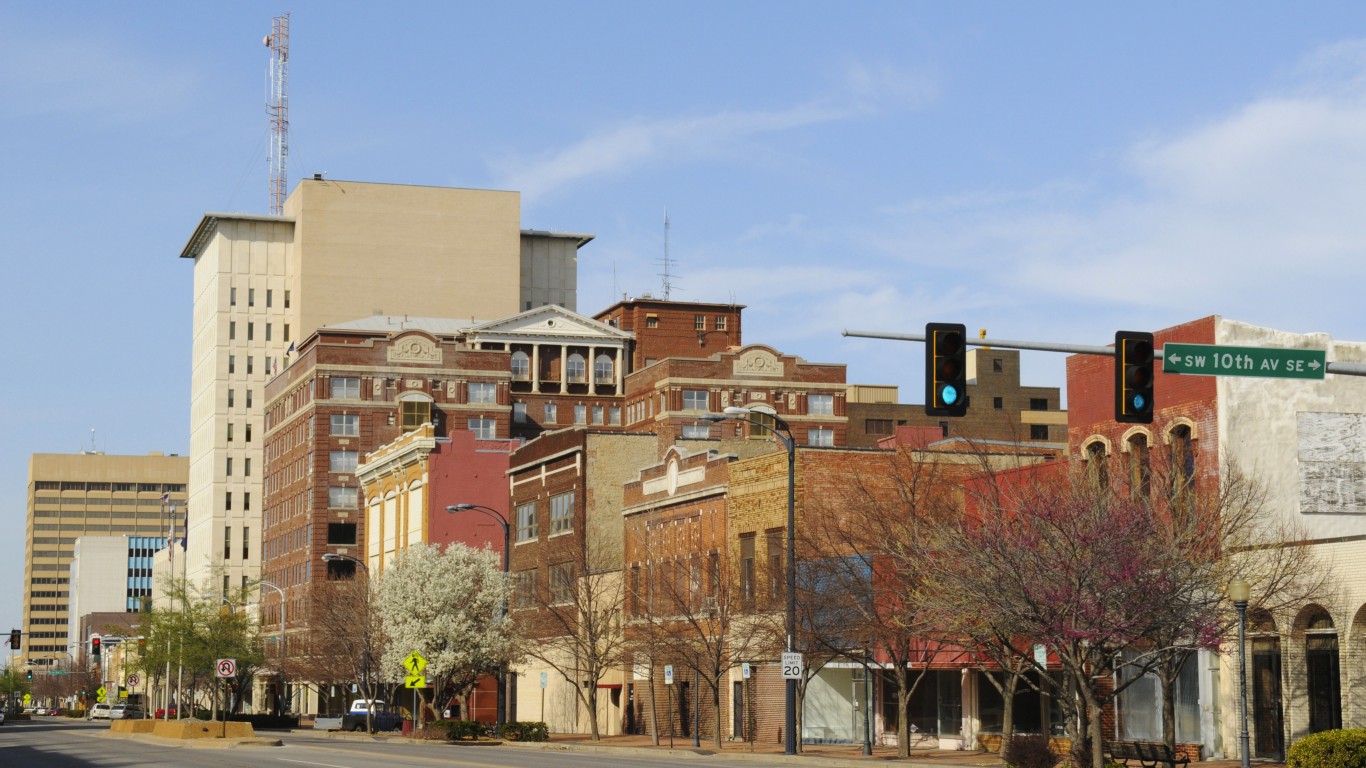
Kansas: Topeka
Avg. new daily cases in Topeka in week ending January 4: 68.7 per 100,000
Avg. new daily cases in Topeka in week ending December 28: 55.6 per 100,000
COVID-19 cases in Topeka as of January 4: 40,809 (17,531.3 per 100,000)
Peak pandemic unemployment in Topeka: 12.4% (April 2020)
Topeka population: 232,778 (72.0 people per sq. mi.)
These are all the counties in Kansas where COVID-19 is slowing (and where it’s still getting worse).
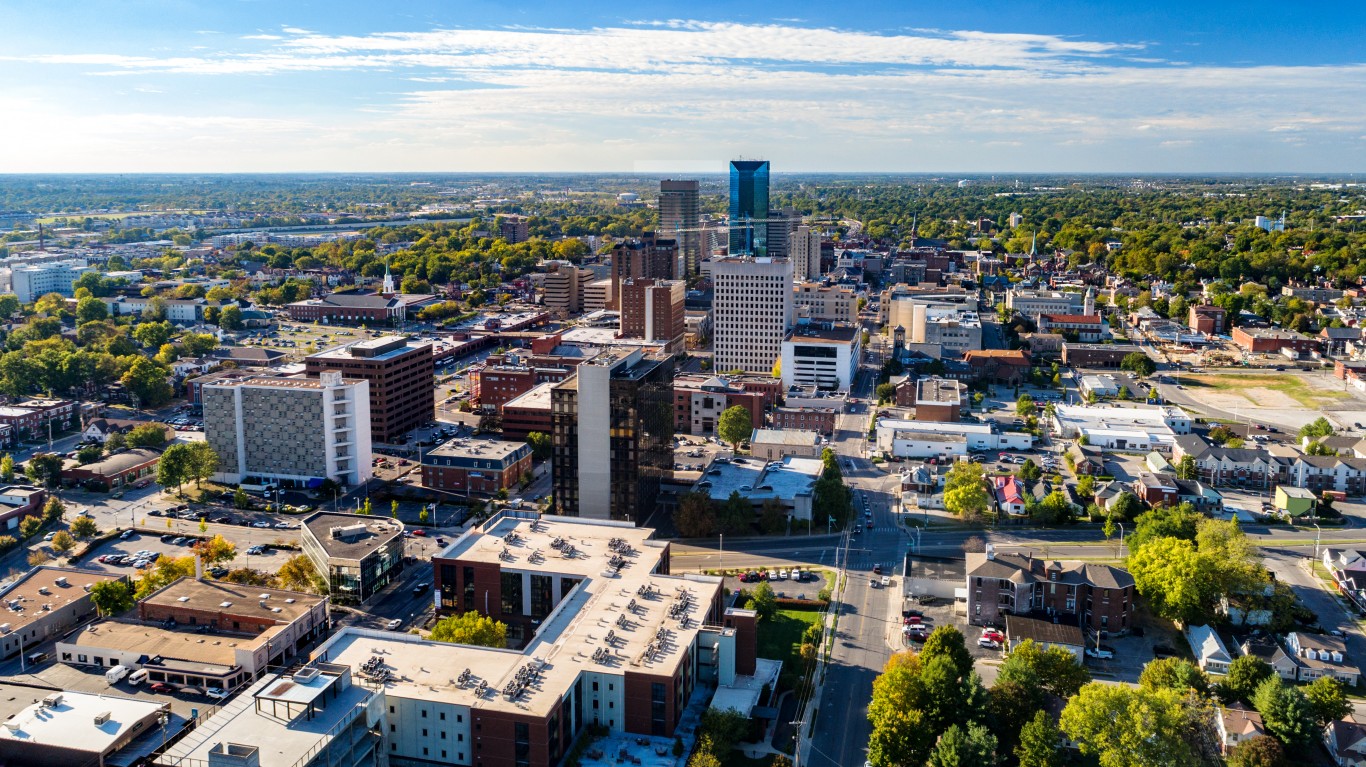
Kentucky: Lexington-Fayette
Avg. new daily cases in Lexington in week ending January 4: 67.2 per 100,000
Avg. new daily cases in Lexington in week ending December 28: 40.7 per 100,000
COVID-19 cases in Lexington as of January 4: 92,139 (18,043.6 per 100,000)
Peak pandemic unemployment in Lexington: 15.8% (April 2020)
Lexington population: 510,647 (347.7 people per sq. mi.)

Louisiana: New Orleans-Metairie
Avg. new daily cases in New Orleans in week ending January 4: 123.0 per 100,000
Avg. new daily cases in New Orleans in week ending December 28: 40.3 per 100,000
COVID-19 cases in New Orleans as of January 4: 214,669 (16,932.7 per 100,000)
Peak pandemic unemployment in New Orleans: 20.0% (April 2020)
New Orleans population: 1,267,777 (396.0 people per sq. mi.)

Maine: Bangor
Avg. new daily cases in Bangor in week ending January 4: 75.6 per 100,000
Avg. new daily cases in Bangor in week ending December 28: 56.0 per 100,000
COVID-19 cases in Bangor as of January 4: 17,516 (11,540.8 per 100,000)
Peak pandemic unemployment in Bangor: 9.6% (April 2020)
Bangor population: 151,774 (44.7 people per sq. mi.)
These are all the counties in Maine where COVID-19 is slowing (and where it’s still getting worse).
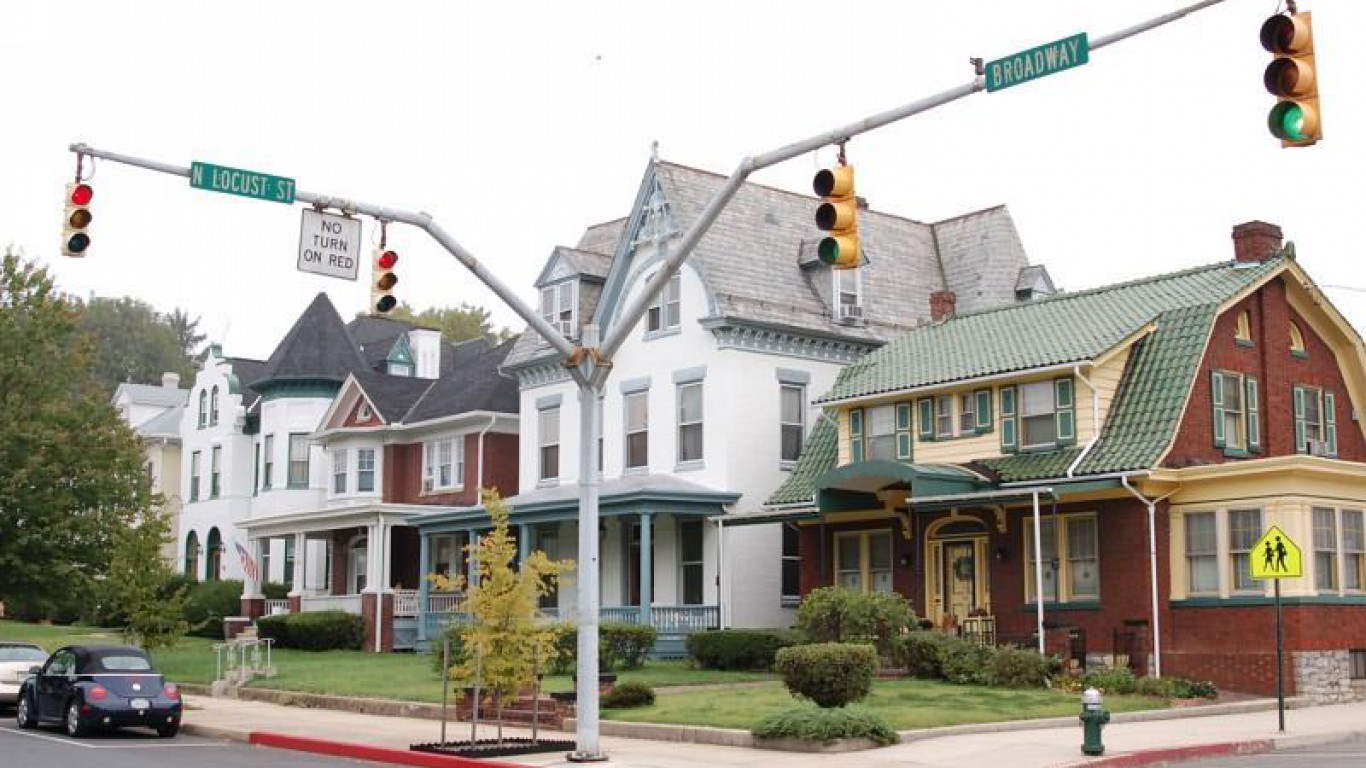
Maryland: Hagerstown-Martinsburg, MD-WV
Avg. new daily cases in Hagerstown in week ending January 4: 193.0 per 100,000
Avg. new daily cases in Hagerstown in week ending December 28: 47.2 per 100,000
COVID-19 cases in Hagerstown as of January 4: 53,505 (18,896.5 per 100,000)
Peak pandemic unemployment in Hagerstown: 12.0% (April 2020)
Hagerstown population: 283,147 (280.9 people per sq. mi.)

Massachusetts: Springfield
Avg. new daily cases in Springfield in week ending January 4: 118.0 per 100,000
Avg. new daily cases in Springfield in week ending December 28: 81.8 per 100,000
COVID-19 cases in Springfield as of January 4: 109,559 (15,662.9 per 100,000)
Peak pandemic unemployment in Springfield: 17.1% (June 2020)
Springfield population: 699,480 (379.4 people per sq. mi.)

Michigan: Detroit-Warren-Dearborn
Avg. new daily cases in Detroit in week ending January 4: 108.5 per 100,000
Avg. new daily cases in Detroit in week ending December 28: 62.2 per 100,000
COVID-19 cases in Detroit as of January 4: 721,869 (16,718.3 per 100,000)
Peak pandemic unemployment in Detroit: 23.2% (May 2020)
Detroit population: 4,317,848 (1,110.4 people per sq. mi.)

Minnesota: Minneapolis-St. Paul-Bloomington, MN-WI
Avg. new daily cases in Minneapolis in week ending January 4: 61.5 per 100,000
Avg. new daily cases in Minneapolis in week ending December 28: 49.7 per 100,000
COVID-19 cases in Minneapolis as of January 4: 635,791 (17,791.3 per 100,000)
Peak pandemic unemployment in Minneapolis: 10.4% (May 2020)
Minneapolis population: 3,573,609 (507.0 people per sq. mi.)

Mississippi: Jackson
Avg. new daily cases in Jackson in week ending January 4: 88.7 per 100,000
Avg. new daily cases in Jackson in week ending December 28: 26.2 per 100,000
COVID-19 cases in Jackson as of January 4: 94,471 (15,805.0 per 100,000)
Peak pandemic unemployment in Jackson: 15.0% (April 2020)
Jackson population: 597,727 (110.6 people per sq. mi.)

Missouri: St. Louis, MO-IL
Avg. new daily cases in St. Louis in week ending January 4: 80.0 per 100,000
Avg. new daily cases in St. Louis in week ending December 28: 42.7 per 100,000
COVID-19 cases in St. Louis as of January 4: 463,634 (16,527.7 per 100,000)
Peak pandemic unemployment in St. Louis: 11.6% (April 2020)
St. Louis population: 2,805,190 (356.7 people per sq. mi.)

Montana: Missoula
Avg. new daily cases in Missoula in week ending January 4: 25.8 per 100,000
Avg. new daily cases in Missoula in week ending December 28: 10.9 per 100,000
COVID-19 cases in Missoula as of January 4: 18,124 (15,449.8 per 100,000)
Peak pandemic unemployment in Missoula: 13.3% (April 2020)
Missoula population: 117,309 (45.2 people per sq. mi.)

Nebraska: Omaha-Council Bluffs, NE-IA
Avg. new daily cases in Omaha in week ending January 4: 64.8 per 100,000
Avg. new daily cases in Omaha in week ending December 28: 39.9 per 100,000
COVID-19 cases in Omaha as of January 4: 175,381 (18,822.2 per 100,000)
Peak pandemic unemployment in Omaha: 10.2% (April 2020)
Omaha population: 931,779 (214.2 people per sq. mi.)

Nevada: Las Vegas-Henderson-Paradise
Avg. new daily cases in Las Vegas in week ending January 4: 45.8 per 100,000
Avg. new daily cases in Las Vegas in week ending December 28: 25.9 per 100,000
COVID-19 cases in Las Vegas as of January 4: 366,051 (16,775.9 per 100,000)
Peak pandemic unemployment in Las Vegas: 34.2% (April 2020)
Las Vegas population: 2,182,004 (276.5 people per sq. mi.)
These are all the counties in Nevada where COVID-19 is slowing (and where it’s still getting worse).

New Hampshire: Manchester-Nashua
Avg. new daily cases in Manchester in week ending January 4: 79.6 per 100,000
Avg. new daily cases in Manchester in week ending December 28: 76.4 per 100,000
COVID-19 cases in Manchester as of January 4: 65,181 (15,781.0 per 100,000)
Peak pandemic unemployment in Manchester: 17.5% (April 2020)
Manchester population: 413,035 (471.4 people per sq. mi.)
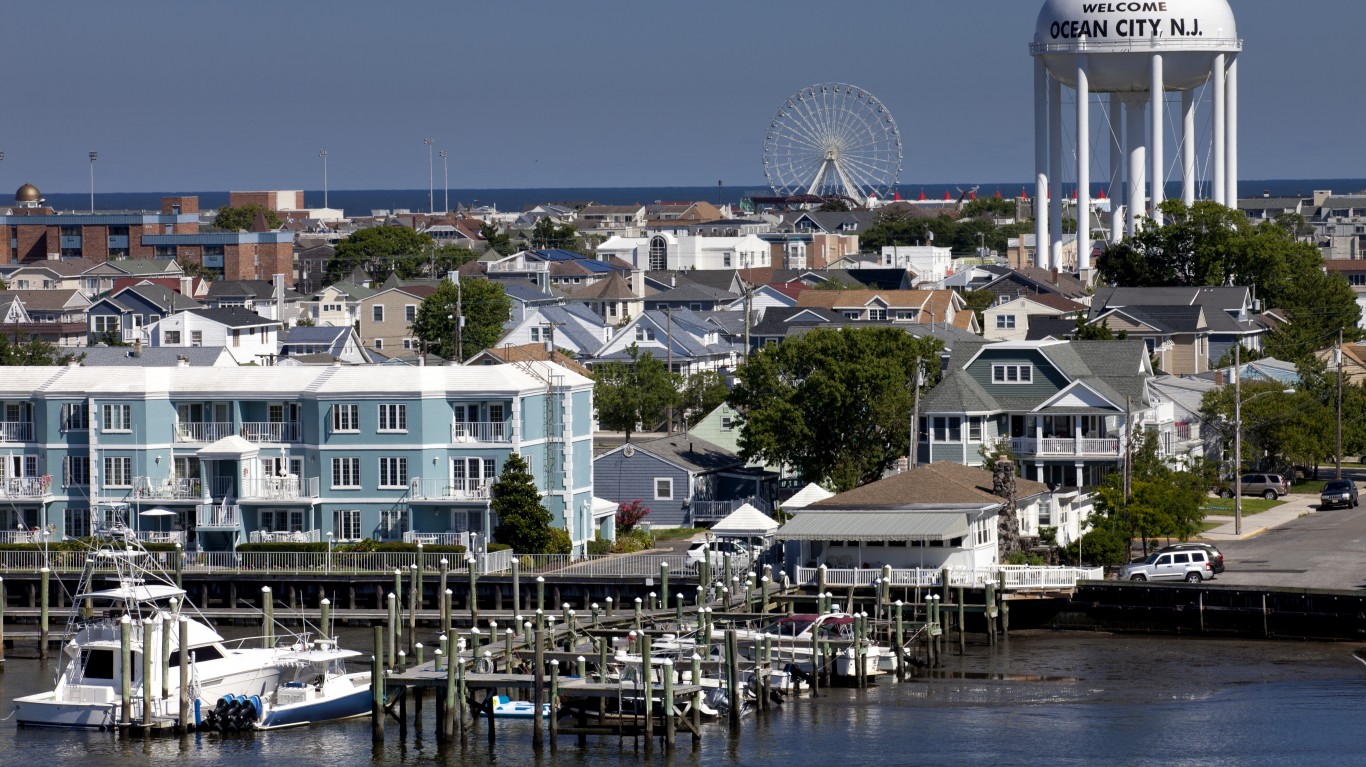
New Jersey: Ocean City
Avg. new daily cases in Ocean City in week ending January 4: 173.1 per 100,000
Avg. new daily cases in Ocean City in week ending December 28: 94.8 per 100,000
COVID-19 cases in Ocean City as of January 4: 17,085 (18,354.0 per 100,000)
Peak pandemic unemployment in Ocean City: 26.6% (June 2020)
Ocean City population: 93,086 (370.2 people per sq. mi.)

New Mexico: Albuquerque
Avg. new daily cases in Albuquerque in week ending January 4: 42.2 per 100,000
Avg. new daily cases in Albuquerque in week ending December 28: 50.9 per 100,000
COVID-19 cases in Albuquerque as of January 4: 134,452 (14,740.8 per 100,000)
Peak pandemic unemployment in Albuquerque: 12.8% (April 2020)
Albuquerque population: 912,108 (98.3 people per sq. mi.)

New York: New York-Newark-Jersey City, NY-NJ-PA
Avg. new daily cases in New York in week ending January 4: 255.8 per 100,000
Avg. new daily cases in New York in week ending December 28: 115.2 per 100,000
COVID-19 cases in New York as of January 4: 3,793,180 (19,659.7 per 100,000)
Peak pandemic unemployment in New York: 17.2% (June 2020)
New York population: 19,294,236 (2,885.4 people per sq. mi.)

North Carolina: Raleigh-Cary
Avg. new daily cases in Raleigh in week ending January 4: 73.5 per 100,000
Avg. new daily cases in Raleigh in week ending December 28: 34.0 per 100,000
COVID-19 cases in Raleigh as of January 4: 200,703 (15,064.3 per 100,000)
Peak pandemic unemployment in Raleigh: 11.7% (May 2020)
Raleigh population: 1,332,311 (629.0 people per sq. mi.)
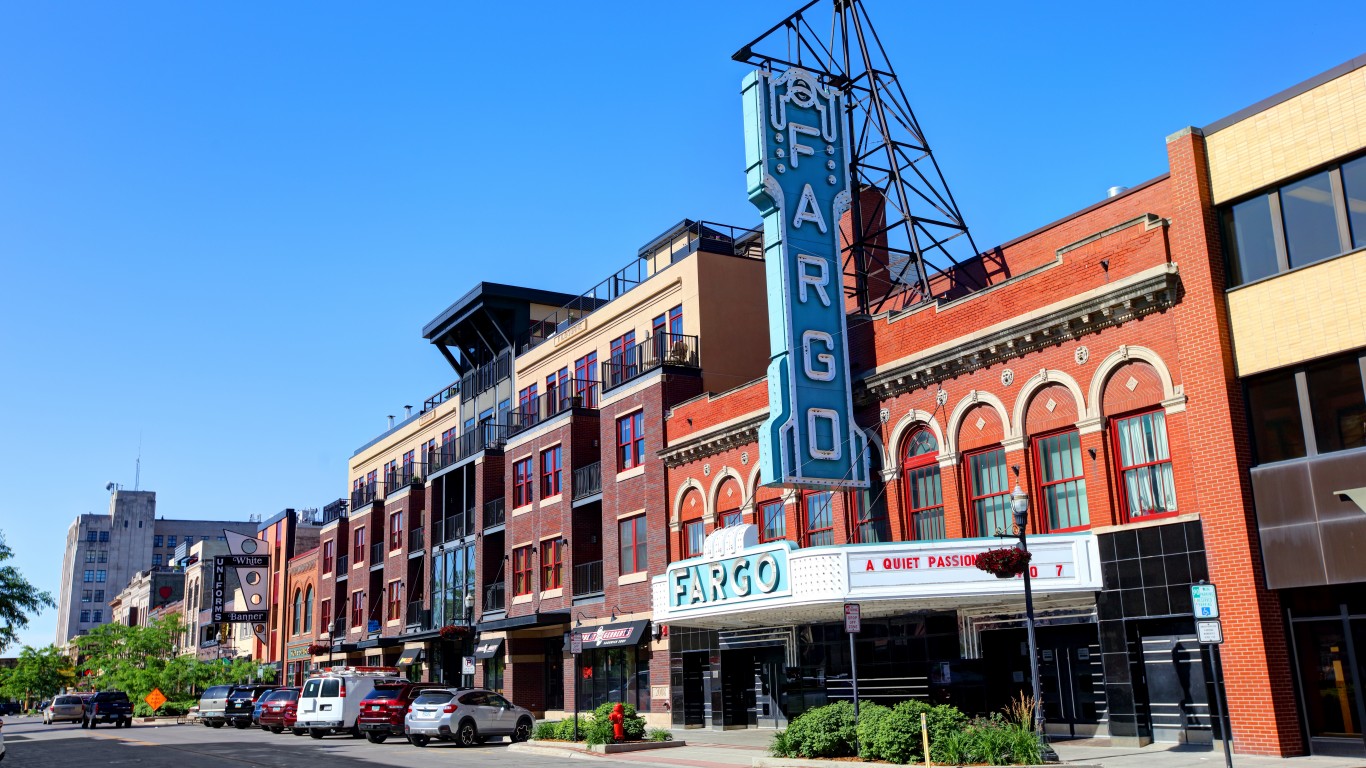
North Dakota: Fargo, ND-MN
Avg. new daily cases in Fargo in week ending January 4: 55.1 per 100,000
Avg. new daily cases in Fargo in week ending December 28: 52.2 per 100,000
COVID-19 cases in Fargo as of January 4: 53,148 (22,106.2 per 100,000)
Peak pandemic unemployment in Fargo: 7.7% (April 2020)
Fargo population: 240,421 (85.5 people per sq. mi.)
Ohio: Cleveland-Elyria
Avg. new daily cases in Cleveland in week ending January 4: 208.5 per 100,000
Avg. new daily cases in Cleveland in week ending December 28: 174.6 per 100,000
COVID-19 cases in Cleveland as of January 4: 377,598 (18,357.6 per 100,000)
Peak pandemic unemployment in Cleveland: 20.2% (April 2020)
Cleveland population: 2,056,898 (1,029.8 people per sq. mi.)
These are all the counties in Ohio where COVID-19 is slowing (and where it’s still getting worse).

Oklahoma: Oklahoma City
Avg. new daily cases in Oklahoma City in week ending January 4: 30.1 per 100,000
Avg. new daily cases in Oklahoma City in week ending December 28: 15.1 per 100,000
COVID-19 cases in Oklahoma City as of January 4: 231,951 (16,773.5 per 100,000)
Peak pandemic unemployment in Oklahoma City: 15.2% (April 2020)
Oklahoma City population: 1,382,841 (250.9 people per sq. mi.)

Oregon: Bend
Avg. new daily cases in Bend in week ending January 4: 59.8 per 100,000
Avg. new daily cases in Bend in week ending December 28: 28.9 per 100,000
COVID-19 cases in Bend as of January 4: 26,067 (13,995.6 per 100,000)
Peak pandemic unemployment in Bend: 18.3% (April 2020)
Bend population: 186,251 (61.7 people per sq. mi.)
These are all the counties in Oregon where COVID-19 is slowing (and where it’s still getting worse).

Pennsylvania: Gettysburg
Avg. new daily cases in Gettysburg in week ending January 4: 193.8 per 100,000
Avg. new daily cases in Gettysburg in week ending December 28: 106.8 per 100,000
COVID-19 cases in Gettysburg as of January 4: 18,658 (18,208.3 per 100,000)
Peak pandemic unemployment in Gettysburg: 14.9% (April 2020)
Gettysburg population: 102,470 (197.6 people per sq. mi.)

Rhode Island: Providence-Warwick, RI-MA
Avg. new daily cases in Providence in week ending January 4: 108.5 per 100,000
Avg. new daily cases in Providence in week ending December 28: 89.3 per 100,000
COVID-19 cases in Providence as of January 4: 312,894 (19,335.1 per 100,000)
Peak pandemic unemployment in Providence: 18.5% (April 2020)
Providence population: 1,618,268 (1,019.8 people per sq. mi.)

South Carolina: Columbia
Avg. new daily cases in Columbia in week ending January 4: 37.2 per 100,000
Avg. new daily cases in Columbia in week ending December 28: 21.9 per 100,000
COVID-19 cases in Columbia as of January 4: 157,115 (19,060.9 per 100,000)
Peak pandemic unemployment in Columbia: 9.4% (May 2020)
Columbia population: 824,278 (222.6 people per sq. mi.)

South Dakota: Sioux Falls
Avg. new daily cases in Sioux Falls in week ending January 4: 61.8 per 100,000
Avg. new daily cases in Sioux Falls in week ending December 28: 37.8 per 100,000
COVID-19 cases in Sioux Falls as of January 4: 58,174 (22,430.9 per 100,000)
Peak pandemic unemployment in Sioux Falls: 10.7% (April 2020)
Sioux Falls population: 259,348 (100.7 people per sq. mi.)

Tennessee: Memphis, TN-MS-AR
Avg. new daily cases in Memphis in week ending January 4: 117.9 per 100,000
Avg. new daily cases in Memphis in week ending December 28: 34.5 per 100,000
COVID-19 cases in Memphis as of January 4: 246,773 (18,421.1 per 100,000)
Peak pandemic unemployment in Memphis: 13.4% (April 2020)
Memphis population: 1,339,623 (292.6 people per sq. mi.)

Texas: Houston-The Woodlands-Sugar Land
Avg. new daily cases in Houston in week ending January 4: 95.0 per 100,000
Avg. new daily cases in Houston in week ending December 28: 46.7 per 100,000
COVID-19 cases in Houston as of January 4: 1,034,598 (15,028.7 per 100,000)
Peak pandemic unemployment in Houston: 14.7% (April 2020)
Houston population: 6,884,138 (833.6 people per sq. mi.)
These are all the counties in Texas where COVID-19 is slowing (and where it’s still getting worse).

Utah: Salt Lake City
Avg. new daily cases in Salt Lake City in week ending January 4: 49.8 per 100,000
Avg. new daily cases in Salt Lake City in week ending December 28: 28.0 per 100,000
COVID-19 cases in Salt Lake City as of January 4: 240,872 (20,055.2 per 100,000)
Peak pandemic unemployment in Salt Lake City: 11.3% (April 2020)
Salt Lake City population: 1,201,043 (156.3 people per sq. mi.)
These are all the counties in Utah where COVID-19 is slowing (and where it’s still getting worse).

Vermont: Burlington-South Burlington
Avg. new daily cases in Burlington in week ending January 4: 87.4 per 100,000
Avg. new daily cases in Burlington in week ending December 28: 56.8 per 100,000
COVID-19 cases in Burlington as of January 4: 22,220 (10,156.1 per 100,000)
Peak pandemic unemployment in Burlington: 14.8% (April 2020)
Burlington population: 218,784 (174.7 people per sq. mi.)

Virginia: Richmond
Avg. new daily cases in Richmond in week ending January 4: 97.3 per 100,000
Avg. new daily cases in Richmond in week ending December 28: 42.7 per 100,000
COVID-19 cases in Richmond as of January 4: 173,784 (13,688.8 per 100,000)
Peak pandemic unemployment in Richmond: 11.7% (April 2020)
Richmond population: 1,269,530 (290.9 people per sq. mi.)
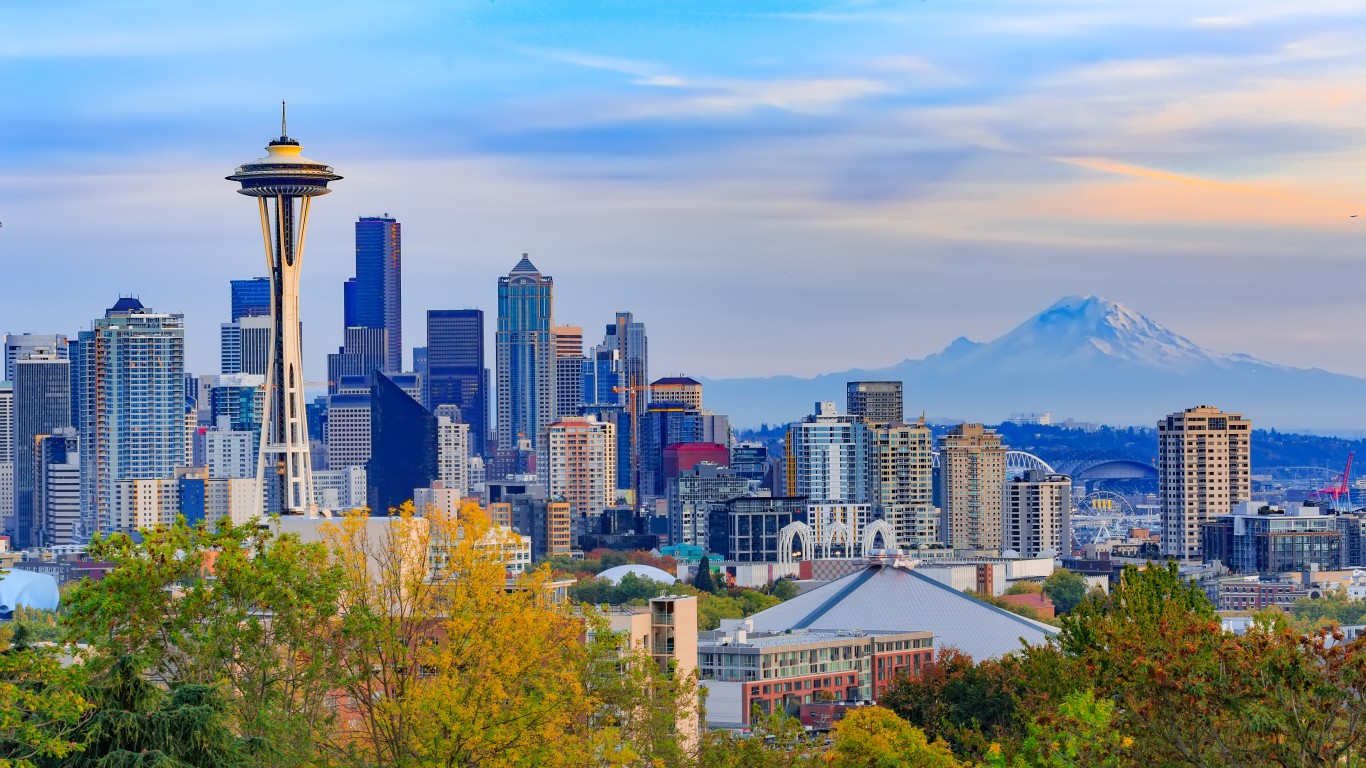
Washington: Seattle-Tacoma-Bellevue
Avg. new daily cases in Seattle in week ending January 4: 84.0 per 100,000
Avg. new daily cases in Seattle in week ending December 28: 27.8 per 100,000
COVID-19 cases in Seattle as of January 4: 391,465 (10,111.9 per 100,000)
Peak pandemic unemployment in Seattle: 17.3% (April 2020)
Seattle population: 3,871,323 (659.2 people per sq. mi.)

West Virginia: Huntington-Ashland, WV-KY-OH
Avg. new daily cases in Huntington in week ending January 4: 63.1 per 100,000
Avg. new daily cases in Huntington in week ending December 28: 50.6 per 100,000
COVID-19 cases in Huntington as of January 4: 69,989 (19,343.0 per 100,000)
Peak pandemic unemployment in Huntington: 17.2% (April 2020)
Huntington population: 361,832 (144.7 people per sq. mi.)

Wisconsin: Racine
Avg. new daily cases in Racine in week ending January 4: 116.9 per 100,000
Avg. new daily cases in Racine in week ending December 28: 66.0 per 100,000
COVID-19 cases in Racine as of January 4: 40,917 (20,918.5 per 100,000)
Peak pandemic unemployment in Racine: 14.4% (April 2020)
Racine population: 195,602 (588.3 people per sq. mi.)
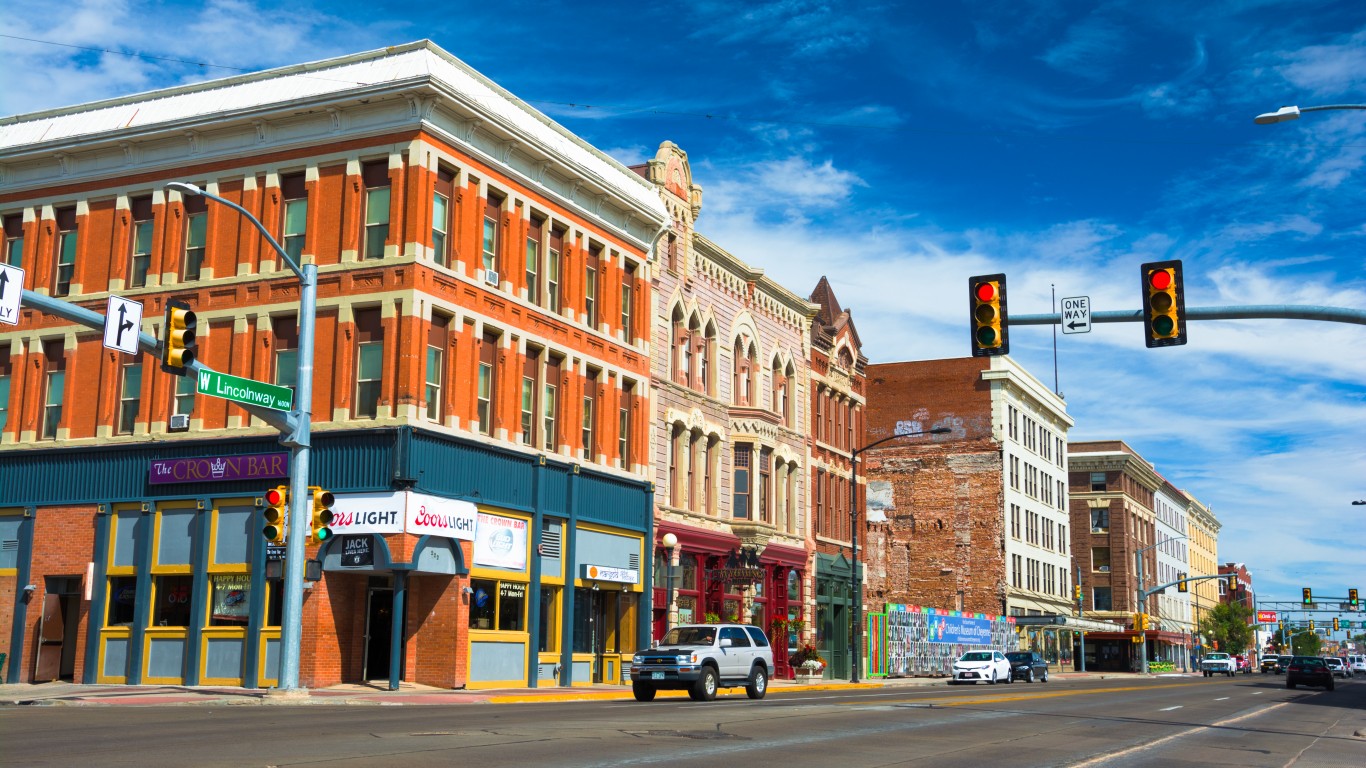
Wyoming: Cheyenne
Avg. new daily cases in Cheyenne in week ending January 4: 30.3 per 100,000
Avg. new daily cases in Cheyenne in week ending December 28: 23.9 per 100,000
COVID-19 cases in Cheyenne as of January 4: 18,648 (18,966.6 per 100,000)
Peak pandemic unemployment in Cheyenne: 9.2% (April 2020)
Cheyenne population: 98,320 (36.6 people per sq. mi.)
Click here to see all coronavirus data for every state.
Thank you for reading! Have some feedback for us?
Contact the 24/7 Wall St. editorial team.